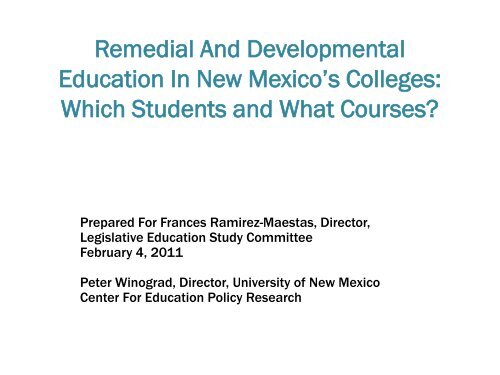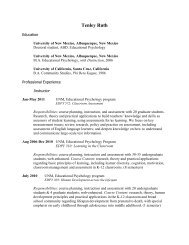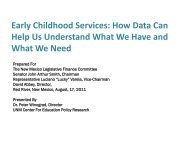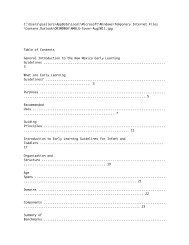Caveat Legislator
Remedial and Developmental Education in New Mexico's Colleges
Remedial and Developmental Education in New Mexico's Colleges
- No tags were found...
Create successful ePaper yourself
Turn your PDF publications into a flip-book with our unique Google optimized e-Paper software.
Fall 2009 Developmental Math Education Classes At Dona Ana Community College(DACC) and Central New Mexico Community College (CNM) By 18 and 19 Year-OldNew Mexico Public High School Graduates Vs. Other Students60%59%50%40%41%30%20%10%0%18-19 Year-Old NM Public High School Graduates (n=3,462) Other Students (n=4,883)Note: These data are Estimates based on the 2010 Ready For College Report and the 2010 DACC and CNM Fact Books7
Fall 2009 Developmental Math Education Classes At Dona Ana Community College(DACC) and Central New Mexico Community College (CNM) By Age50%44%40%30%20%23%12% 12%10%6%2%0%18 and Under (n=1,948) 19-24 (n=3,677) 26-30 (n=1,025)31-40 (n=966) 41-40 (n=525) Over 50 (n=204)Note: These data from the 2010 DACC and CNM Fact Books8
Percent of Adults 25 to 34 with an Associates Degree or Higher - 20099
Percent of the population with a two-year or four-year college degree, ages 25-34© 2008 Lumina Foundation | 800.834.5756 |10
Percent of New Mexico Public High School Graduates Who Took RemedialClasses In Math And/Or Reading In New Mexico Colleges: 2000-200960%50%46.2%47.6%50.3% 50.5% 50.8% 50.4%49.3% 50.1% 50.2%47.1%40%30%20%10%0%2000 (n=6,696) 2001 (n=6,623) 2002 (n=7,170) 2003 (n=7,618) 2004 (n=7,616)2005 (n=7,668) 2006 (n=7,687) 2007 (n=8,900) 2008 (n=9,346) 2009 (n=9,713)Note: These data are from the 2010 Ready For College Report and do not includecharter schools or alternative schools. Those data are available in the full report.11
What Courses?Developmental Courses vs. Remedial Courses• New Mexico’s colleges and universities use the Classification Of Instructional Programs(CIP) code developed by the National Center For Education Statistics to classify courses.• Developmental education courses usually include:• Basic Skills, General – CIP 32.0101• Basic Skills, Other – CIP 32.0199• Career Exploration – CIP 32.0107• Literacy And Communication Skills – CIP 32.0108• Numeracy and Computation Skills – CIP 32.0104• The Ready For College Reports which show that approximately 47.1% of high schoolgraduates take remedial courses used data from two types of higher educationdevelopmental courses:• Literacy And Communication Skills – CIP 32.0108• Numeracy and Computation Skills – CIP 32.0104• We recommend an updated analyses of how colleges and universities decide whichcourses are classified as developmental and which courses are offered at differentinstitutions.• Determining which higher education courses are considered developmental and whichof those are considered remedial is a critical distinction in current policy discussions.12
Fall 2009 Developmental Classes At Dona Ana Community College (DACC)and Central New Mexico Community College (CNM) By CIP Codes60%54%50%40%33%30%20%10%11%0%1%1%Basic Skills, General – CIP 32.0101 Basic Skills, Other – CIP 32.0199Career Exploration – CIP 32.0107 Literacy And Communication Skills – CIP 32.0108Numeracy and Computation Skills – CIP 32.0104Note: These data are Estimates based on the 2010 DACC and CNM Fact Books.13
The Ongoing Challenge OfRemedial and Developmental Classes In College• We support New Mexico’s efforts to:• Ensure that students graduate from high school ready for success in college andcareers.• Help working-age adults develop the skills they need to enter or strengthen theworkforce.• We believe that high schools and colleges should:• Improve the alignment in standards and assessments used in K-12 education andhigher education. Particular focus should be paid to the cut scores colleges use to placestudents in remedial classes.• Improve their communication about how to support students making the transition.HB70 -Education Data System, passed in 2010, calls for colleges to report freshmanyear outcomes back to high schools, and the Governor and Legislature should monitorthe implementation and impact of these reports of carefully.• We hope that New Mexico uses the opportunity afforded by HB70 to continue todevelop reports that track the effectiveness of the education system. We suggest two:• Reports that track the effectiveness of remedial and development courses in helpingstudents succeed in college and in their careers.• Reports that track how well prepared the high percentage of high school graduates whodo not attend college are for the workplace.14
The University of New Mexico Center For Education PolicyResearch (UNM-CEPR)• UNM-CEPR’s mission is to conduct independent, high quality research using educationaldata that can inform policy and practice throughout New Mexico’s P-20 education system.• UNM-CEPR has a number of key goals including:• Providing policymakers, educators, community members and others with data presented in waysthat inform the important debates in education.• Fostering and sustaining a rigorous and broad-based education research program for the benefitof New Mexicans.• Cultivating communication and maintaining collaborative relationships with a broad-basedspectrum of agencies and constituencies.• Assembling teams of leading policy analysts and social scientists to work with school data on keyeducational issues and problems facing the state.• Creating new venues in which practitioners, policymakers, and researchers can regularly useeducational data to address current issues.• Cultivating a new generation of scholars focused on educational data and policy impact.• Contact Information:• Email: Peterwin@unm.edu• Phone: 505-340-566415





